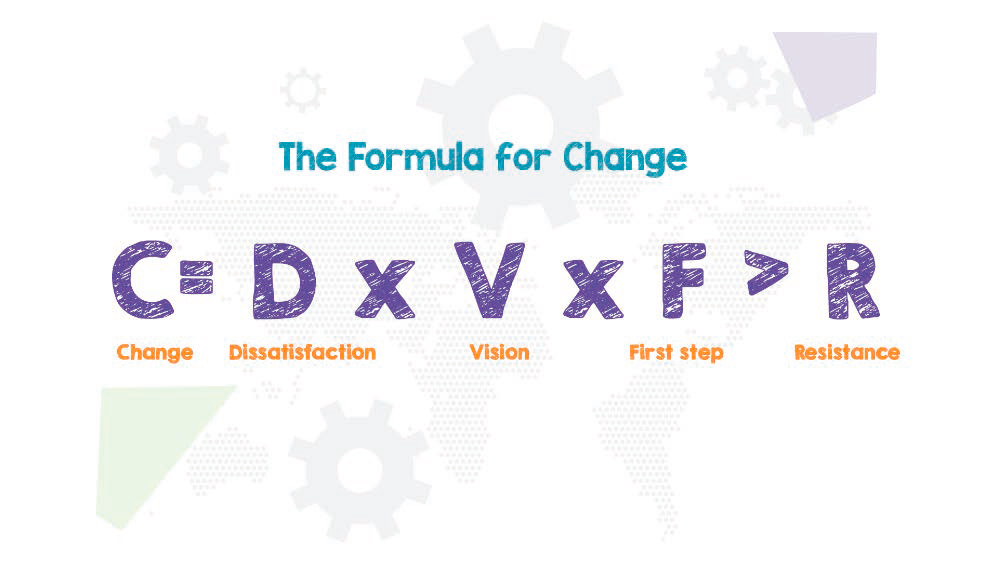Have you ever thought about the ingredients necessary to make a sustainable organisational change? And if you did, what would those components of change be? Fortunately, this thinking has already been done and can be easily applied to any change management project or initiative.
So, for a lift company, to what changes might this apply? The answer is many and various, big and small. A few ideas might include:
A small company moving from a subcontractor role to a full-fledged independent with its own customer base
- A slightly larger company might consider splitting the major works into separate installation and repairs teams
- The transition of one engineer from one department to another
- The need to take on a business development/salesperson
- The need to take on a regional office
- The implementation of a new computer system
By way of history, in the 1960s, there was a guy called David Gleicher who, whilst working at the consultancy practice Arthur D Little, developed a formula for change. In the 1980s, the formula was further refined by Kathie Dannemiller, and it essentially provides a model to assess the relative strengths affecting the likely success of an organisational change program.
The original formula, created by Gleicher and published by Richard Beckard is: C = A × B × D > X where:
- C is change,
- A is the status quo dissatisfaction,
- B is a desired clear state,
- D is practical steps to the desired state and
- X is the cost of the change.
The now more common Dannemiller version is:
What this means is three factors must be present for meaningful organisational change to take place.
These factors are:
- D = Dissatisfaction with how things are now
- V = Vision of what is possible
- F = First concrete steps that can be taken towards the vision And the product of these three factors needs to be greater than
- R = Resistance
Essentially, you need to ensure you overcome resistance, so a picture needs to be painted where dissatisfaction with the current situation is high, there is a compelling vision of the future and the first steps on that journey to the vision have been established. If all of these components are in place, there is a good chance of resistance being overcome and change being made.
However, the converse is also true. The formula for change suggests that a successful organisational change is possible only when the product of D, V and F is greater than the resistance to change. Since the formula involves the multiplication of the three variables, if any variable is completely missing or too low, the end result will also be low. This implies that falling short on any one of these variables will make it difficult to get past the (always present) organisational resistance.
How to use the concept
D – Dissatisfaction with the current situation
If people are completely satisfied with the current situation, they will have no reason or motivation to change. So, management needs to explain why the current situation is unacceptable or what is undesirable about the way things are being done currently.
Take a real-life example. Why would you change your refrigerator if you have no problems with it? (My dad is very proud of the fact that he has a fridge, his beer fridge, that he bought before I was born, and at the time of this writing, I’m at least 30! Well, possibly a bit older; okay, nearly twice that!) When you are comfortable in your current situation, you have no inclination to leave your comfort zone and embrace change. Change is welcomed only when there is a high degree of dissatisfaction.
To create that willingness for change, you need to explain why things cannot go on the way they currently are. When you’re trying to publicise dissatisfaction, you need to throw light on three different perspectives:
- problems for your organisation as a whole
- problems for your consumers or clients
- problems for your colleagues and fellow staff
V – Vision of the possibilities
If you’re not aware that life could be better, or that the company could have better results, (whatever that means for the change being pursued) why would you (or others) embark on the change?
To accept and embrace change, there needs to be a concrete and tangible vision of a better future and better results. The picture painted of what lies ahead has to be crystal clear, which means that management has to make efforts to get everyone to buy into this vision of the future.
When we talk about the vision of the future, every person involved will be keen to know what’s in store for them. Thus, when painting this picture of the future, you must explain how the organisation will benefit from the change and what will be the employee’s new place or role after the change.
The clearer the vision, the more enthusiastic people will be to invest effort into realising it. Let people know how the change will benefit them, and they are far more likely to become foot soldiers on the march to achieving the change.
F – First steps towards change
The formula suggests that being dissatisfied with the current situation and possessing only a beautifully painted vision of the future is not enough to motivate people to change. That’s where the third variable of the formula for change steps in.
The people you are leading need to know if there is a
clear-cut strategy to achieve the vision, so set out and properly articulate what will be done and how it will be done. People need to know there is a well thought out and realistic plan of action plan in place.
Conclusion
It’s a cliché to say the only constant is change, but did you know the original recording of this saying was actually 2,500 years ago and originally uttered by the pre-Socratic philosopher Heraclitus?
There will always be change; some will see it, some will deny it and others will embrace it. But as leaders and managers, we need to manage it and manage our people through it, and on the shoulders of giants, we can stand. The work of Gleicher and Dannemiller gives us a concept we can use to ponder and consider the impacts of the changes we need to make and how to mobilise staff so they can make that journey, at worst, willingly, and at best, enthusiastically.
Related tools
- Force Field Analysis
- RACI – (Responsible, Accountable, Consulted and Informed)
Recommended references
- Who Moved my Cheese by Spencer Johnson, a fantastic little book on change management, can be read in a couple of hours.
- Our Iceburg is Melting by John Kotter, a fable of resistance to change and heroic action
- The Heart of Change by John Kotter, real-life stories from people in the change management trenches
has a background in engineering. After completing an award winning apprenticeship he completed a degree in Mechanical and Production Engineering. He also has an MBA from Bradford University where he studied with Professor J.S. Oakland, the world’s first Professor of Total Quality Management. During the time he spent in industry he gained extensive experience of both implementing new technology and strategic appraisal. Mark is now a managing partner of Statius Management Services, a management consultancy specialising in performance improvement a subject on which Mark has published a number of papers and articles.
Get more of Elevator World. Sign up for our free e-newsletter.







